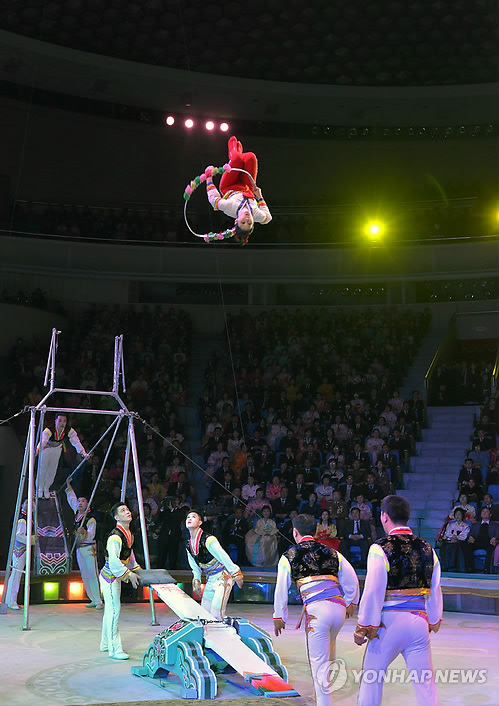 Image: Yonhap News Agency |
Mongolia’s international circus festival will take place from March 23rd to 29th and feature international performers from Mongolia, China, Russia, Spain, and North
Korea.
The North Korean performers hail from the
renowned Pyongyang National Circus, known for its application of a unique flying trapeze technique, which is characterized by a quadruple front and back flip along with a triple seesaw jump. Typical performances in North Korea consist of various acts involving trapezes, seesaws, bicycle acrobatics, animals, juggling,
clowns, and magicians. Not only that, the Pyongyang National Circus
employs a multitude of environmental elements in its performances, flying through the air, skidding over ice, and swimming under water.
 Image: Yonhap News Agency |
The selection process for the Pyongyang
National Circus is a rigorous one: from the age of nine only the top athletes
are recruited to follow nine years of training, based on criteria such as facial
beauty and symmetry, flexibility, height, physique, etc. After intensive
gymnastics training the recruits choose to enter one of seven performance
sections: air circus, land circus, water circus, ice circus, animal circus,
magic, and clowning. Technique is paramount in the North Korean circus but, surprisingly, humor also plays a pivotal role in keeping audiences engaged.
Most importantly, at international
festivals of this sort the North Korean authorities do not push ideological
notions or propaganda, letting the art speak for itself. Kim Jong Il defined the circus as “a refined art,”
with a fixed place within North Korean society because it “maintains and
transmits our pure ideology, intelligence, bravery, and determination to people.” His reason for doing so stemmed from a desire to avoid intertwining the notion of the “circus,” associated with capitalist
art and culture, with “gyoye,” or “refined art.”
 Image: Yonhap News Agency |
These performances offer one of the best
forms of cultural exchanges currently available with North Korea; the Pyongyang National Circus is an oft-requested guest by international festivals around the world, even coming to Seoul in 2000.
After securing the golden
elephant in March, the top prize offered at the Figueres international circus
festival, the Pyongyang team will perform the same routine in Mongolia. The same
number also won a golden clown at the Monte-Carlo Circus Festival in January, trumping
China’s team. Further bolstering the group’s success was ranking first place at the Cirque
de Demain Festival, the Moscow IDOL Festival, and the Massy Circus Festival.
North Korea’s renowned circus troupe offers the
rare opportunity to transcend cultural stereotypes and breakdown barriers between North
Korea and the international community, allowing audiences to appreciate art in and of itself, rather than intertwine it with politics. North Korea performs in front of audiences regardless of their background–“hostile powers” or otherwise– presenting an opportunity
for the world to appreciate these performers’ myriad talents, rather
than branding their work “socialist art” or “capitalist art.”
 Image: Yonhap News Agency |
















